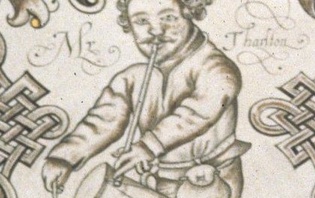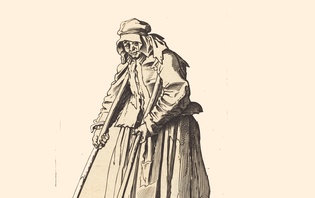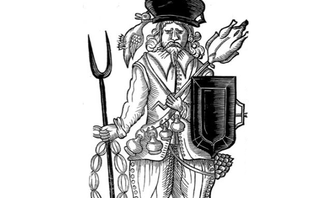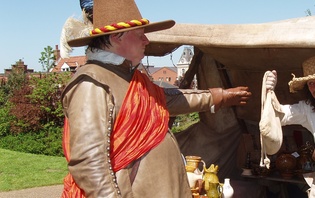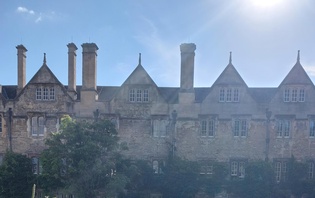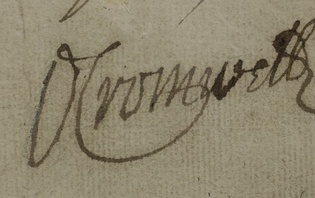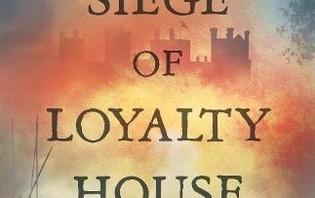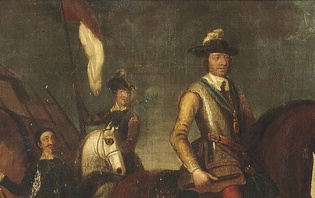The Wounded of Naseby
Fought on 14 June 1645, Naseby has long been considered the decisive engagement of the First Civil War. There are many well-known sources for the conduct and experiences of the rival leaders and commanders. Yet little was known about the fate of those wounded at Naseby until the publication of Glenn Foard’s landmark monograph of 1995, Naseby: The Decisive Campaign. Therefore, on 7 February 2020, Andrew Hopper was delighted to be invited by Arthur, Lord Hazlerigg, to speak about Naseby’s wounded in order to promote the opening of the Naseby 375th anniversary exhibition at Daventry Museum on behalf of the Naseby Battlefield Project. One highlight of the exhibition is this little known painting of the battlefield of Naseby from c.1680 by an unknown artist (and we are most grateful to Daventry Museum for permission to reproduce this here). It appears to be derived from the better known engraving by Robert Streeter, and can also be seen on p. 51 of Martin Marix Evans’s Osprey book on Naseby (see ‘Further Reading’). It exaggerates the hilly terrain of Naseby and labels the parliamentarian forces ‘The Rebells’. Thanks to Civil War Petitions, which can now be searched by events such as battles, our published petitions and certificates are already revealing to us more about the identities of those individual wounded troopers and soldiers that made up the regiments depicted on this painting.
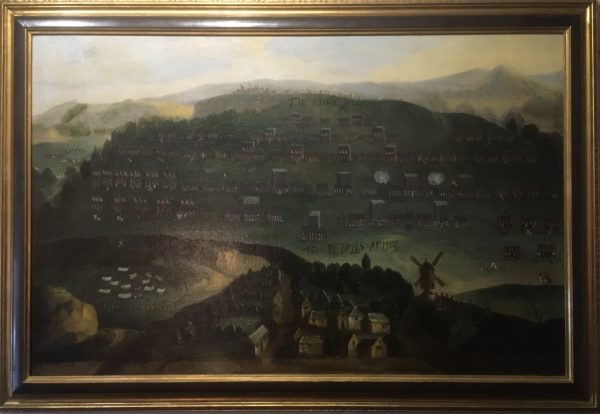
The Battle of Naseby by an Unknown Artist c. 1680 (copyright Daventry Museum)
Glenn Foard’s book established more about the treatment of the better-documented parliamentarian wounded than their royalist counterparts. Those parliamentarians who were too dangerously injured to be moved were quartered for days afterwards in the timber-framed and cob cottages of Naseby village, where local inhabitants nursed them in their own homes. In an appendix in his book, Foard summarized an account held among the Commonwealth Exchequer Papers in the National Archives (SP 28/173, Part 1). This account names 535 parliamentarian wounded, arranged by regiment, who were brought into Northampton after the battle. Of these 44 later died of their wounds and are marked individually ‘mortuus est’. The Committee of the Army granted the wounded £700 and this account shows how over £697 of that sum was disbursed to pay for the surgery, nursing, diet and accommodation of individual soldiers. Some wounded were treated in St John’s Hospital on Bridge Street, while others were fed and nursed in the ‘hospitall barne’. Northampton and Wellingborough householders were paid for quartering wounded soldiers. Payments were listed to named surgeons and unnamed nurses and surgeons’ mates. Thomas Brighton was paid five pounds for transporting eighteen wounded to hospital in London. Casualties were heaviest in Sergeant-Major General Philip Skippon’s regiment of foot, which bore the brunt of the royalist infantry’s attack, and suffered 139 wounded, on top of those killed outright.
Commanders of the New Model Army were among the wounded too. The commander-in-chief, Sir Thomas Fairfax was fortunate to emerge unscathed, when after losing his helmet and refusing a replacement, he charged bare-headed into the enemy. Colonel Edward Whalley had his coat cut ‘in many peeces’ but remained unharmed. Commissary-General Henry Ireton had his horse shot under him, and was run through the thigh with a pike. He was also struck in the face with a halberd and temporarily captured. Yet Ireton recovered from these wounds quite quickly to participate in the storming of Bristol three months later.
Of all those wounded at Naseby, we know the most about Sergeant-Major General Skippon, thanks to the research of our project manager, Ismini Pells. Dr Pells has shown how Skippon was accidentally shot in his right side by one of his own musketeers. Fortunately, the bullet missed his spine and vital organs but it left him with an eight-inch-long exit-wound on his left side. Skippon refused to leave the field, saying ‘He would not go so long as a Man would stand’. Consequently, he lost much blood, whilst a rag from his waistcoat got stuck in the wound and infected it. Afterwards, Skippon was taken to a nearby house to have his wound dressed but soon fell into a fever. The House of Commons paid to send Skippon his own doctor and surgeon from London to tend his wound, whilst his regimental surgeon removed the scrap of waistcoat festering in it. A month later, Skippon was transported to London. As his horse-litter was drawn through Islington, a great mastiff surprised and attacked one of the horses. This shook the litter violently and Skippon’s wounded body inside it. Eventually, a soldier ran the dog through with a sword, saving Skippon’s life. Ultimately, Skippon’s treatment cost hundreds of pounds. He was fortunate to survive. He took eleven months to recover before returning to active duty at the siege of Oxford in May 1646.
Royalist casualties were much heavier, especially because the parliamentarian cavalry pursued the retreating royalists for five miles, killing and wounding several hundred after the main battle had finished. The day after the battle, 4,508 royalist prisoners, including some wounded were marched from Market Harborough to Northampton. Accommodated in parish churches on their southward march to London, they passed though Olney, Bedford, Dunstable, Luton, St Albans and Barnet. There were wounded among these prisoners, because surgeons were dispatched to treat them from the parliamentarian garrison at Newport Pagnell. On 21 June, about 3,000 prisoners were paraded through London and Westminster. One French onlooker was surprised by how well they looked, which suggests that by this stage few of the royalist wounded were left among them. They were kept in the Artillery Ground near Tuttle Fields while Parliament considered their disposal.
The London-based Committee of Adventurers for Ireland paid for the treatment of Naseby’s wounded royalist prisoners who volunteered to fight for Parliament in Ireland. Around 800 did so. All others who refused to forsake armed royalism risked deportation overseas. Many spent the next year or more in prison, but around 1,000 of them eventually joined the New Model Army. They were attracted by the regular pay and relative safety of service, as by summer 1646 little fighting appeared necessary. The royalist Sir Philip Warwick recalled that after Oxford’s surrender in June 1646, Fairfax told him that ‘the best common soldiers he had’ were formerly in royalist service: ‘So (sayes he) I found you had made them good soldiers, & I have made them good men.’
Many of Naseby’s wounded died well after the battle’s conclusion, sometimes years or even decades later, having lived with terrible pain from lingering wounds. Payments for those who returned home can sometimes be found in parish records. For example, that churchwardens’ accounts of Stockton in Norfolk, kindly shared with us by Tim Wales, list a payment of fifteen shillings to John Bird when he was pressed into military service for the parish in 1643. Bird received a further ten shillings from them to pay for ten days of military training. While John was away on service, the parish made the occasional weekly payment of a shilling to his wife, along with donations of hemp, timber for fuel, and repairs to the Birds’ chimney and their daughter’s shoes. After Naseby, John was listed among the wounded in Captain Tomkins’s company of Colonel John Pickering’s regiment of foot, and received eight shillings to pay for his treatment. He received a further two shillings from Stockton churchwardens when he ‘returned home maimed from Nas[e]by fight’. The parish paid for John’s wife to nurse him over a period of 41 weeks, amounting to a total of two pounds and a shilling. The parish were paying for another maimed soldier, John Rivet, and the upkeep of two more lame soldiers at the village inn. By 1647 John had passed away, as thereafter the accounts change from naming Goodwife Bird to Widow Bird. Into 1648, Widow Bird continued to receive wood, hemp, cheese and money from the parish, amounting to five pounds of the parish’s total annual outgoings of twelve pounds fourteen shillings. She was still in receipt of payments in 1658 when the parish relieved her during her own sickness. This moving example shows us how caring for the war’s wounded, widowed and orphaned could make serious inroads into parish finances for years afterward.
A search of the material uploaded so far onto Civil War Petitions reveals ten maimed royalist soldiers, to just one parliamentarian maimed soldier and one widow of a parliamentarian. In 1655, William Yorke of Coggeshall petitioned Essex justices that he had served at Naseby, and had ‘received very dangerous wounds’, though not it seems at Naseby as his name is missing from the list of wounded. Ten years on, these now caused him such pain that they disabled William from employment. He was left with six children to support, and had been refused parish relief because Coggeshall was ‘full of necessitous poor people’. His petition was endorsed by four of his neighbours but its outcome remains unknown. The following year, Margaret Walker, also of Coggeshall, petitioned that her husband, Peter, had served at Naseby among Colonel Rainsborough’s regiment, but had been killed subsequently at Sherborne Castle, leaving her a ‘poor distressed widow’. Margaret’s petition set out that she was no longer able to earn her living because of her age and sickness. Her claim was supported by eighteen neighbours, no doubt hoping to lower their own burden by shifting Margaret’s maintenance away from parish relief and onto a county pension. She was awarded a pension of forty shillings per year, a fairly standard sum.
The royalist wounded were unable to apply for a pension legally until after the Restoration in 1660, leaving us with the interesting question of how they got by before then. A flood of royalist petitioners came forward during the reign of Charles II, displacing their parliamentarian predecessors in the process. Among the ten royalist petitioners to mention Naseby that have been uploaded so far, three were from Denbighshire, three were from Herefordshire, two troopers were from Yorkshire and one each came from Northamptonshire and Lincolnshire. The most striking of their petitions is that of Rowland Harrison of Whitby, a trooper in Prince Rupert’s regiment from when the King first raised his standard at Nottingham in August 1642. Petitioning aged seventy in 1685, Harrison appears to have retained vivid memories of his Civil-War exploits, including, that at Naseby he was ‘one of the nine that escaped out of the three and thirty that went out of Prince Rupert Regiment’. Nine of his neighbours, including local gentry, endorsed his petition, suggesting that by 1685 he had become something of a local character. Sir Hugh Cholmley vouched that Harrison’s petition was true ‘having heard the same confirmed for more than thirty years that the petitioner hath been known to me.’ Occasionally our petitions provide us with wonderful insights like these into how oral memories circulated in the post-war decades.
Among other royalist petitioners, Thomas ap Richard of Wrexham, a Denbighshire trooper complained he had ‘lost his health and wasted his estate in the said service’. He received a pension of twenty shillings in 1664. John Hughes, also of Denbighshire, served in the regiment of Sir Thomas Salusbury, and was taken prisoner at Naseby ‘being then miserably wounded, was shot through the leg’, and was afterwards held prisoner in Leicester ‘in a woeful condition’. William Wilson of Gisburn was entered onto the pensioners’ roll by West Riding justices in 1677, thereby endorsing his claim that he had been a trooper wounded at ‘Kneasbie field’.
In Herefordshire in 1668, John Howells petitioned the Mayor of Hereford for a place as an almsman in the city’s hospital, having served at Naseby and suffered ‘divers hurts, wounds, bruises and maims’, as well as losing his sight. John Evans of Hereford petitioned the Mayor in 1684 that he had served in Prince Rupert’s regiment of foot, and been wounded and captured at Naseby. Like many other petitioners, he drew attention to his imprisonment: sixteen weeks as ‘close prisoner’, in ‘thraldom of misery’ in London. He was granted a pitiful four pence per week by the corporation. The following year the Herefordshire county justices only granted bread to the value of sixpence a week to the seventy-year-old William Jones of Bodenham, who petitioned that he had been pressed from the parish of his birth into Sir Jacob Astley’s regiment, only to be wounded at Naseby.
Over and above the royalist soldiers wounded at Naseby, we should also remember the women maimed and killed at Farndon Field following the battle. This has been the subject of an important article by our co-investigator, Mark Stoyle, who reveals in one of our previous blogs, Echoes of a Massacre, that Elizabeth Burgess, a servant in the royal household, was among the victims of this atrocity. The suggestion that many of those that were maimed or killed alongside Elizabeth were wives and relatives of Welsh royalist soldiers is supported by the presence of Denbighshire petitions mentioning Naseby after 1660. The numbers of petitioners that reference Naseby are so far insufficient to support any broad conclusions. But over the next twelve months, as increasing numbers of petitions and certificates are uploaded for our forthcoming counties, much more about the identities of Naseby’s wounded will surely be revealed.
Further Reading
Glenn Foard, Naseby: The Decisive Campaign (Whitstable, 1995), including appendix 3, ‘Parliamentarian Wounded’, pp. 408–413.
Barbara Donagan, ‘Casualties of war: treatment of the dead and wounded in the English Civil War’, in Ian Gentles, John Morrill and Blair Worden (eds), Soldiers, Writers and Statesmen of the English Revolution (Cambridge: Cambridge University Press, 1998), pp. 114–32.
Martin Marix Evans, Naseby 1645: The Triumph of the New Model Army (Oxford: Osprey, 2007), p. 51.
Ismini Pells, ‘ “Stout Skippon hath a wound”: the medical treatment of Parliament’s infantry commander following the Battle of Naseby’, in David Appleby and Andrew Hopper (eds), Battle-Scarred: Mortality, Medical Care and Military Welfare during the British Civil Wars (Manchester, 2018), pp. 78–94.
Mark Stoyle, ‘The Road to Farndon Field: Explaining the Massacre of the Royalist Women at Naseby’, The English Historical Review, 123 (2008), pp. 895–923.
Tim Wales, ‘The Parish and the Poor in the English Revolution’, in Stephen Taylor and Grant Tapsell (eds), The Nature of the English Revolution Revisited (Woodbridge: Boydell, 2013), pp. 53–80.

